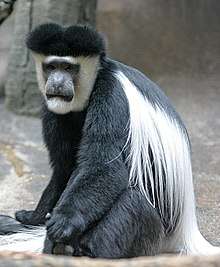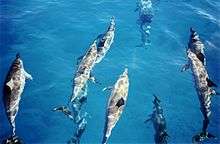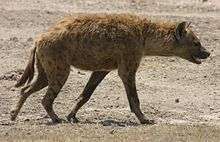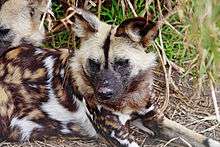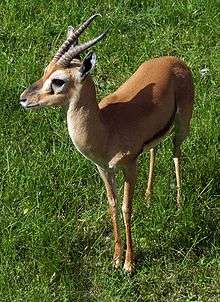List of mammals of Eritrea
This is a list of the mammal species recorded in Eritrea. Of the mammal species in Eritrea, one is critically endangered, two are endangered, ten are vulnerable, and three are near threatened.[1]
The following tags are used to highlight each species' conservation status as assessed by the International Union for Conservation of Nature:
| EX | Extinct | No reasonable doubt that the last individual has died. |
| EW | Extinct in the wild | Known only to survive in captivity or as a naturalized populations well outside its previous range. |
| CR | Critically endangered | The species is in imminent risk of extinction in the wild. |
| EN | Endangered | The species is facing an extremely high risk of extinction in the wild. |
| VU | Vulnerable | The species is facing a high risk of extinction in the wild. |
| NT | Near threatened | The species does not meet any of the criteria that would categorise it as risking extinction but it is likely to do so in the future. |
| LC | Least concern | There are no current identifiable risks to the species. |
| DD | Data deficient | There is inadequate information to make an assessment of the risks to this species. |
Some species were assessed using an earlier set of criteria. Species assessed using this system have the following instead of near threatened and least concern categories:
| LR/cd | Lower risk/conservation dependent | Species which were the focus of conservation programmes and may have moved into a higher risk category if that programme was discontinued. |
| LR/nt | Lower risk/near threatened | Species which are close to being classified as vulnerable but are not the subject of conservation programmes. |
| LR/lc | Lower risk/least concern | Species for which there are no identifiable risks. |
Subclass: Theria
Infraclass: Eutheria
Order: Tubulidentata (aardvarks)
The order Tubulidentata consists of a single species, the aardvark. Tubulidentata are characterised by their teeth which lack a pulp cavity and form thin tubes which are continuously worn down and replaced.
- Family: Orycteropodidae
- Genus: Orycteropus
- Aardvark, Orycteropus afer LC
- Genus: Orycteropus
Order: Hyracoidea (hyraxes)

The hyraxes are any of four species of fairly small, thickset, herbivorous mammals in the order Hyracoidea. About the size of a domestic cat they are well-furred, with rounded bodies and a stumpy tail. They are native to Africa and the Middle East.
- Family: Procaviidae (hyraxes)
- Genus: Heterohyrax
- Yellow-spotted rock hyrax, Heterohyrax brucei LC
- Genus: Procavia
- Cape hyrax, Procavia capensis LC
- Genus: Heterohyrax
Order: Proboscidea (elephants)
The elephants comprise three living species and are the largest living land animals.
- Family: Elephantidae (elephants)
- Genus: Loxodonta
- African bush elephant, Loxodonta africana VU
- Genus: Loxodonta
Order: Sirenia (manatees and dugongs)
Sirenia is an order of fully aquatic, herbivorous mammals that inhabit rivers, estuaries, coastal marine waters, swamps, and marine wetlands. All four species are endangered.
- Family: Dugongidae
Order: Primates
The order Primates contains humans and their closest relatives: lemurs, lorisoids, tarsiers, monkeys, and apes.
- Suborder: Strepsirrhini
- Infraorder: Lemuriformes
- Superfamily: Lorisoidea
- Family: Galagidae
- Genus: Galago
- Senegal bushbaby, Galago senegalensis LR/lc
- Genus: Galago
- Family: Galagidae
- Superfamily: Lorisoidea
- Infraorder: Lemuriformes
- Suborder: Haplorhini
- Infraorder: Simiiformes
- Parvorder: Catarrhini
- Superfamily: Cercopithecoidea
- Family: Cercopithecidae (Old World monkeys)
- Genus: Chlorocebus
- Grivet, Chlorocebus aethiops LR/lc
- Genus: Papio
- Olive baboon, Papio anubis LR/lc
- Hamadryas baboon, Papio hamadryas LR/nt
- Genus: Theropithecus
- Gelada, Theropithecus gelada LR/nt
- Genus: Chlorocebus
- Subfamily: Colobinae
- Genus: Colobus
- Mantled guereza, Colobus guereza LR/lc
- Genus: Colobus
- Family: Cercopithecidae (Old World monkeys)
- Superfamily: Cercopithecoidea
- Parvorder: Catarrhini
- Infraorder: Simiiformes
Order: Rodentia (rodents)
Rodents make up the largest order of mammals, with over 40% of mammalian species. They have two incisors in the upper and lower jaw which grow continually and must be kept short by gnawing. Most rodents are small though the capybara can weigh up to 45 kg (99 lb).
- Suborder: Hystricognathi
- Family: Hystricidae (Old World porcupines)
- Genus: Hystrix
- Crested porcupine, Hystrix cristata LC
- Genus: Hystrix
- Family: Hystricidae (Old World porcupines)
- Suborder: Sciurognathi
- Family: Sciuridae (squirrels)
- Subfamily: Xerinae
- Tribe: Xerini
- Genus: Xerus
- Striped ground squirrel, Xerus erythropus LC
- Unstriped ground squirrel, Xerus rutilus LC
- Genus: Xerus
- Tribe: Protoxerini
- Genus: Heliosciurus
- Gambian sun squirrel, Heliosciurus gambianus LC
- Genus: Heliosciurus
- Tribe: Xerini
- Subfamily: Xerinae
- Family: Gliridae (dormice)
- Subfamily: Graphiurinae
- Genus: Graphiurus
- Small-eared dormouse, Graphiurus microtis LC
- Genus: Graphiurus
- Subfamily: Graphiurinae
- Family: Dipodidae (jerboas)
- Subfamily: Dipodinae
- Genus: Jaculus
- Lesser Egyptian jerboa, Jaculus jaculus LC
- Genus: Jaculus
- Subfamily: Dipodinae
- Family: Cricetidae
- Subfamily: Lophiomyinae
- Family: Muridae (mice, rats, voles, gerbils, hamsters, etc.)
- Subfamily: Deomyinae
- Genus: Acomys
- Mullah spiny mouse, Acomys mullah LC
- Genus: Acomys
- Subfamily: Gerbillinae
- Genus: Gerbillus
- Somalia gerbil, Gerbillus dunni DD
- Genus: Tatera
- Fringe-tailed gerbil, Tatera robusta LC
- Genus: Gerbillus
- Subfamily: Murinae
- Genus: Arvicanthis
- Abyssinian grass rat, Arvicanthis abyssinicus LC
- African grass rat, Arvicanthis niloticus LC
- Genus: Mus
- Delicate mouse, Mus tenellus LC
- Genus: Stenocephalemys
- Ethiopian white-footed mouse, Stenocephalemys albipes LC
- Genus: Arvicanthis
- Subfamily: Deomyinae
- Family: Ctenodactylidae
- Genus: Pectinator
- Speke's pectinator, Pectinator spekei DD
- Genus: Pectinator
- Family: Sciuridae (squirrels)
Order: Lagomorpha (lagomorphs)
The lagomorphs comprise two families, Leporidae (hares and rabbits), and Ochotonidae (pikas). Though they can resemble rodents, and were classified as a superfamily in that order until the early 20th century, they have since been considered a separate order. They differ from rodents in a number of physical characteristics, such as having four incisors in the upper jaw rather than two.
Order: Erinaceomorpha (hedgehogs and gymnures)
The order Erinaceomorpha contains a single family, Erinaceidae, which comprise the hedgehogs and gymnures. The hedgehogs are easily recognised by their spines while gymnures look more like large rats.
- Family: Erinaceidae (hedgehogs)
- Subfamily: Erinaceinae
- Genus: Hemiechinus
- Desert hedgehog, Hemiechinus aethiopicus LR/lc
- Genus: Hemiechinus
- Subfamily: Erinaceinae
Order: Soricomorpha (shrews, moles, and solenodons)
The "shrew-forms" are insectivorous mammals. The shrews and solenodons closely resemble mice while the moles are stout-bodied burrowers.
- Family: Soricidae (shrews)
- Subfamily: Crocidurinae
- Genus: Crocidura
- Savanna shrew, Crocidura fulvastra LC
- Mauritanian shrew, Crocidura lusitania LC
- Savanna path shrew, Crocidura viaria LC
- Genus: Crocidura
- Subfamily: Crocidurinae
Order: Chiroptera (bats)
The bats' most distinguishing feature is that their forelimbs are developed as wings, making them the only mammals capable of flight. Bat species account for about 20% of all mammals.
- Family: Pteropodidae (flying foxes, Old World fruit bats)
- Subfamily: Pteropodinae
- Genus: Eidolon
- Straw-coloured fruit bat, Eidolon helvum LC
- Genus: Epomophorus
- Ethiopian epauletted fruit bat, Epomophorus labiatus LC
- Genus: Rousettus
- Egyptian fruit bat, Rousettus aegyptiacus LC
- Genus: Eidolon
- Subfamily: Pteropodinae
- Family: Vespertilionidae
- Subfamily: Vespertilioninae
- Genus: Barbastella
- Asian barbastelle, Barbastella leucomelas LR/lc
- Genus: Eptesicus
- Botta's serotine, Eptesicus bottae LC
- Genus: Neoromicia
- Cape serotine, Neoromicia capensis LC
- Banana pipistrelle, Neoromicia nanus LC
- Somali serotine, Neoromicia somalicus LC
- Genus: Nycticeinops
- Schlieffen's bat, Nycticeinops schlieffeni LC
- Genus: Plecotus
- Ethiopian big-eared bat, Plecotus balensis VU
- Genus: Scotophilus
- African yellow bat, Scotophilus dinganii LC
- Genus: Barbastella
- Subfamily: Vespertilioninae
- Family: Rhinopomatidae
- Genus: Rhinopoma
- Lesser mouse-tailed bat, Rhinopoma hardwickei LC
- Greater mouse-tailed bat, Rhinopoma microphyllum LC
- Genus: Rhinopoma
- Family: Molossidae
- Genus: Chaerephon
- Spotted free-tailed bat, Chaerephon bivittata LC
- Little free-tailed bat, Chaerephon pumila LC
- Genus: Mops
- Midas free-tailed bat, Mops midas LC
- Genus: Tadarida
- African giant free-tailed bat, Tadarida ventralis NT
- Genus: Chaerephon
- Family: Emballonuridae
- Genus: Coleura
- African sheath-tailed bat, Coleura afra LC
- Genus: Taphozous
- Naked-rumped tomb bat, Taphozous nudiventris LC
- Genus: Coleura
- Family: Nycteridae
- Genus: Nycteris
- Egyptian slit-faced bat, Nycteris thebaica LC
- Genus: Nycteris
- Family: Megadermatidae
- Genus: Cardioderma
- Heart-nosed bat, Cardioderma cor LC
- Genus: Lavia
- Yellow-winged bat, Lavia frons LC
- Genus: Cardioderma
- Family: Rhinolophidae
- Subfamily: Rhinolophinae
- Genus: Rhinolophus
- Blasius's horseshoe bat, Rhinolophus blasii NT
- Geoffroy's horseshoe bat, Rhinolophus clivosus LC
- Rüppell's horseshoe bat, Rhinolophus fumigatus LC
- Lesser horseshoe bat, Rhinolophus hipposideros LC
- Genus: Rhinolophus
- Subfamily: Hipposiderinae
- Genus: Asellia
- Patrizi's trident leaf-nosed bat, Asellia patrizii VU
- Trident leaf-nosed bat, Asellia tridens LC
- Genus: Hipposideros
- Sundevall's roundleaf bat, Hipposideros caffer LC
- Ethiopian large-eared roundleaf bat, Hipposideros megalotis NT
- Genus: Asellia
- Subfamily: Rhinolophinae
Order: Cetacea (whales)
The order Cetacea includes whales, dolphins and porpoises. They are the mammals most fully adapted to aquatic life with a spindle-shaped nearly hairless body, protected by a thick layer of blubber, and forelimbs and tail modified to provide propulsion underwater.
- Suborder: Odontoceti
- Superfamily: Platanistoidea
- Family: Delphinidae (marine dolphins)
- Genus: Delphinus
- Long-beaked common dolphin, Delphinus capensis DD
- Genus: Globicephala
- Short-finned pilot whale, Globicephala macrorhyncus DD
- Genus: Grampus
- Risso's dolphin, Grampus griseus DD
- Genus: Orcinus
- Killer whale, Orcinus orca DD
- Genus: Sousa
- Indian humpback dolphin, Sousa plumbea DD
- Genus: Stenella
- Pantropical spotted dolphin, Stenella attenuata DD
- Striped dolphin, Stenella coeruleoalba DD
- Spinner dolphin, Stenella longirostris DD
- Genus: Steno
- Rough-toothed dolphin, Steno bredanensis DD
- Genus: Tursiops
- Common bottlenose dolphin, Tursiops truncatus
- Indo-Pacific bottlenose dolphin, Tursiops aduncus
- Genus: Delphinus
- Family: Delphinidae (marine dolphins)
- Superfamily Ziphioidea
- Family: Ziphidae (beaked whales)
- Genus: Indopacetus
- Tropical bottlenose whale, Indopacetus pacificus DD
- Genus: Mesoplodon
- Ginkgo-toothed beaked whale, Mesoplodon ginkgodens DD
- Blainville's beaked whale, Mesoplodon densirostris DD
- Genus: Indopacetus
- Family: Ziphidae (beaked whales)
- Superfamily: Platanistoidea
Order: Carnivora (carnivorans)
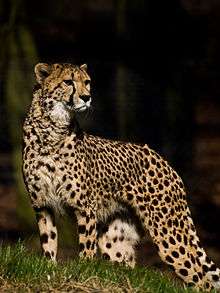
There are over 260 species of carnivorans, the majority of which feed primarily on meat. They have a characteristic skull shape and dentition.
- Suborder: Feliformia
- Family: Felidae (cats)
- Subfamily: Felinae
- Genus: Acinonyx
- Species: Acinonyx jubatus VU
- Genus: Caracal
- Caracal, Caracal caracal LC
- Genus: Felis
- African wildcat, Felis lybica LC
- Genus: Leptailurus
- Serval, Leptailurus serval LC
- Genus: Acinonyx
- Subfamily: Pantherinae
- Genus: Panthera
- Species: Panthera leo VU
- Species: Panthera pardus NT
- African leopard, P. p. pardus
- Genus: Panthera
- Subfamily: Felinae
- Family: Hyaenidae (hyaenas)
- Genus: Crocuta
- Spotted hyena, Crocuta crocuta LR/cd
- Genus: Hyaena
- Striped hyena, Hyaena hyaena LR/nt
- Genus: Proteles
- Aardwolf, Proteles cristatus LR/lc
- Genus: Crocuta
- Family: Felidae (cats)
- Suborder: Caniformia
- Family: Canidae (dogs, foxes)
- Genus: Vulpes
- Pale fox, Vulpes pallida DD
- Genus: Canis
- African golden wolf, Canis anthus NE
- Black-backed jackal, Canis mesomelas LC
- Genus: Lycaon
- Somali wild dog, Lycaon pictus somalicus EN
- Genus: Vulpes
- Family: Mustelidae (mustelids)
- Genus: Ictonyx
- Striped polecat, Ictonyx striatus LR/lc
- Genus: Mellivora
- Ratel, Mellivora capensis LR/lc
- Genus: Lutra
- Speckle-throated otter, Lutra maculicollis LC
- Genus: Aonyx
- African clawless otter, Aonyx capensis LC
- Genus: Ictonyx
- Family: Canidae (dogs, foxes)
Order: Perissodactyla (odd-toed ungulates)
The odd-toed ungulates are browsing and grazing mammals. They are usually large to very large, and have relatively simple stomachs and a large middle toe.
- Family: Equidae (horses etc.)
- Genus: Equus
- Somali wild ass, Equus africanus somaliensis CR
- Genus: Equus
Order: Artiodactyla (even-toed ungulates)
The even-toed ungulates are ungulates whose weight is borne about equally by the third and fourth toes, rather than mostly or entirely by the third as in perissodactyls. There are about 220 artiodactyl species, including many that are of great economic importance to humans.
- Family: Suidae (pigs)
- Subfamily: Phacochoerinae
- Genus: Phacochoerus
- Desert warthog, Phacochoerus aethiopicus LR/lc
- Common warthog, Phacochoerus africanus LR/lc
- Genus: Phacochoerus
- Subfamily: Phacochoerinae
- Family: Giraffidae (giraffe, okapi)
- Subfamily: Giraffa
- Nubian giraffe, Giraffa camelopardalis camelopardalis EN
- Subfamily: Giraffa
- Family: Bovidae (cattle, antelope, sheep, goats)
- Subfamily: Alcelaphinae
- Genus: Alcelaphus
- Hartebeest, Alcelaphus buselaphus LR/cd
- Genus: Alcelaphus
- Subfamily: Antilopinae
- Genus: Gazella
- Dorcas gazelle, Gazella dorcas VU
- Red-fronted gazelle, Gazella rufifrons VU
- Soemmerring's gazelle, Gazella soemmerringii VU
- Genus: Madoqua
- Salt's dik-dik, Madoqua saltiana LR/lc
- Genus: Oreotragus
- Klipspringer, Oreotragus oreotragus LR/cd
- Genus: Ourebia
- Oribi, Ourebia ourebi LR/cd
- Genus: Gazella
- Subfamily: Bovinae
- Genus: Tragelaphus
- Greater kudu, Tragelaphus strepsiceros LR/cd
- Genus: Tragelaphus
- Subfamily: Hippotraginae
- Subfamily: Alcelaphinae
- Family: Camelidae
See also
Notes
- This list is derived from the IUCN Red List which lists species of mammals and includes those mammals that have recently been classified as extinct (since 1500 AD). The taxonomy and naming of the individual species is based on those used in existing Wikipedia articles as of 21 May 2007 and supplemented by the common names and taxonomy from the IUCN, Smithsonian Institution, or University of Michigan where no Wikipedia article was available.
References
- "The IUCN Red List of Threatened Species: Mammals of Eritrea". IUCN. 2001. Retrieved 22 May 2007.
- "Mammal Species of the World". Smithsonian National Museum of Natural History. 2005. Archived from the original on 27 April 2007. Retrieved 22 May 2007.
- "Animal Diversity Web". University of Michigan Museum of Zoology. 1995–2006. Retrieved 22 May 2007.



